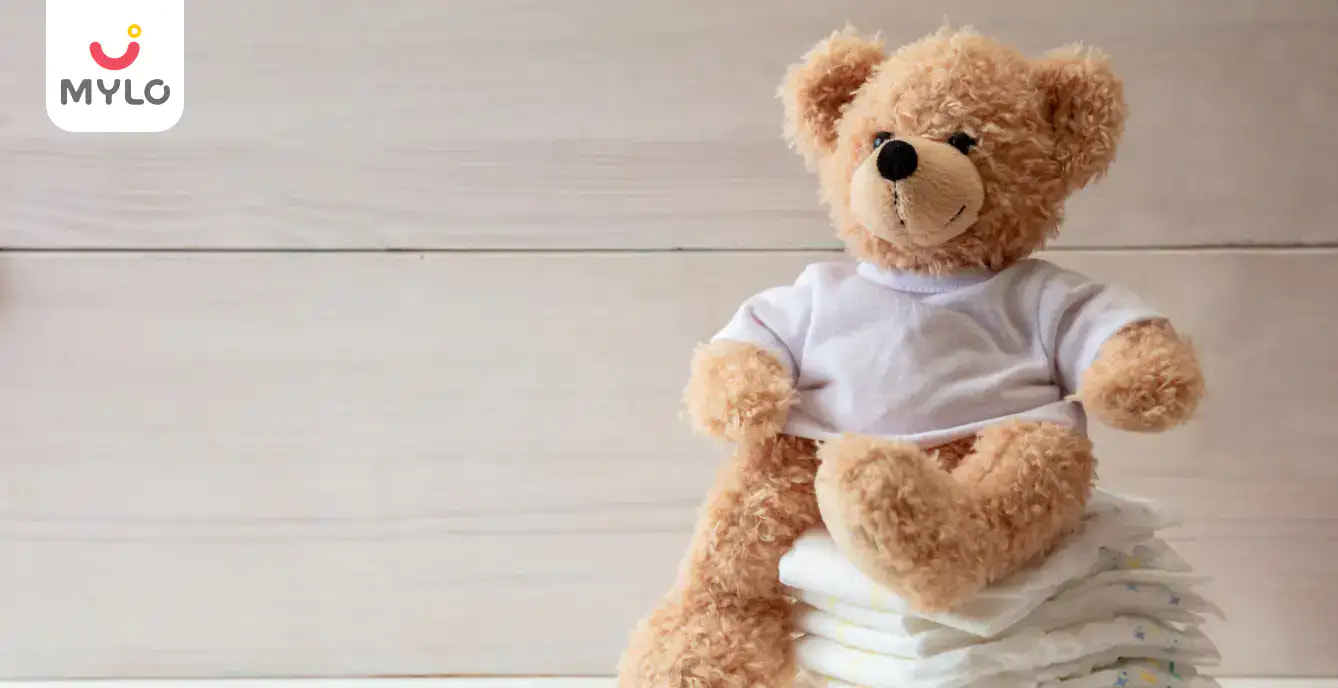In this Article
Diapering
How Long Should You Make Your Baby Wear Disposable Diapers?
Updated on 3 November 2023
New parents have a lot of decisions to make when it comes to taking care of their little ones. As a new parent, one of the most important decisions you will make is choosing the right type of diaper for your baby. Cloth diapers versus disposable diapers is a common debate among new parents. While cloth diapers have their benefits, disposable diapers are often more convenient, practical, and widely used. However, with so many diaper brands, sizes, and features available, it can be challenging to determine how long your baby should wear disposable diapers.
In this article, we will discuss some general guidelines and recommendations for how long you should make your baby wear disposable diapers and the merits and demerits of disposable diapers.
How Long Can You Use Disposable Diapers for Babies?
Disposable diapers have been a lifesaver for many parents, offering convenience, ease of use, and reliable protection for their babies. However, it's important to know when it's time to change to a larger size or switch to a different type of diaper. Generally, newborns will need to be changed more frequently than older babies. As your baby grows, you'll need to adjust the diaper size and change frequency accordingly. Most disposable diaper brands provide a weight range for each size, but it's important to check for signs of discomfort, leakage, or irritation as well.
You may also like: A Beginners Guide: How to Change a Baby's Diaper?
On average, newborn babies wear diapers for 4-6 weeks before they move up to size 1 diapers. There are multiple factors that can affect when a baby moves up to the next size diaper, such as weight and length. Generally, babies who are smaller outgrow their diapers sooner than those who are bigger, since they need more room to move around in a larger diaper.
Most babies with average height and weight are ready to move up to size 2 diapers after 3-5 months. Once your baby has crossed the six month milestone and are growing well, they are most likely ready for another diaper size upgrade. Babies over the age of 6 months are ready to wear size 3 diapers.
For the first few months of life, a baby’s diaper weight is used to track how he or she is growing and doing overall. So if the baby starts out on the lower end of the growth chart, it may take a little longer for him or her to move up to the next size diaper. Some babies may need to be changed more frequently than others, and it is important to keep an eye on disposable diapers for babies for output and bowel movements.
You may also like: Diaper Size And Weight Chart Guide
When is the Right Time to Take Off a Disposable Diaper?
There was a time when parents would take their babies off diapers by the time they turned one. This was, however, because most parents relied on reusable and cloth diapers. Obviously, washing them was a problem. Now, thanks to disposable diapers, some parents keep their babies in diapers until they are 24 months old and some even till the age of three! But as a standard practice, it is agreed that three years might be too old, and parents can start potty training their children after they have crossed their 18th month. So even if they are not mentally prepared to move on from a disposable diaper, they should be able to use the toilet when the time comes.
Merits of Disposable Diapers
A disposable diaper comes with the following advantages:
1. Convenience
Disposable diapers are easy to use and dispose of, making them a convenient option for parents on-the-go or those with busy lifestyles.
2. Absorbency
Disposable baby diapers are designed to absorb moisture quickly and effectively, keeping your baby dry and comfortable for longer periods of time.
3. Hygiene
Disposable diapers are made with materials that are designed to prevent leaks and promote hygiene, reducing the risk of diaper rash, infections, and other skin irritations.
4. Affordability
Disposable diaper pants are available at reasonable prices and across a wide range of brands, making them an affordable option for new parents.
5. Variety
Disposable baby diapers come in a wide range of sizes, styles, and features, allowing parents to choose the one that best suits their baby's needs and preferences. From newborn to toddler sizes, there's a disposable diaper out there for every stage of your baby's development.
Demerits of Disposable Diapers
While disposable diapers offer many advantages, there are also some potential drawbacks to consider:
1. Environmental impact
Disposable diapers are not as eco-friendly as their competitors, cloth diapers. They contribute significantly to landfill waste, taking hundreds of years to decompose. They also require a significant amount of resources to manufacture and transport.
2. Chemicals and fragrances
Some diapers contain chemicals and fragrances that can irritate a baby's skin or cause allergic reactions. These chemicals can also be harmful to the environment. So, it becomes important to choose the right disposable diaper brand for your baby.
3. Cost
While disposable diapers are affordable in the long run, the cost of buying them regularly can be a significant expense for some families, especially those on a tight budget. Additionally, the cost of disposable diapers can add up quickly if you need to change them frequently due to leaks or other issues.
Conclusion
It is important to choose the right size and absorbency level of diapers that fit your baby's needs and comfort. A little awareness of when to change the diaper can go a long way in helping the baby stay happy. While there are advantages and disadvantages to using disposable diapers, the decision ultimately comes down to personal preference and lifestyle. Remember to also consider the impact of disposable diapers on the environment and your budget. By taking all these factors into account, you can make an informed decision and ensure your baby stays dry, comfortable, and healthy.



Written by
Mittali Khurana
Mittali is a content writer by profession. She is a dynamic writer with 04+ years of experience in content writing for E-commerce, Parenting App & Websites, SEO.
Read MoreGet baby's diet chart, and growth tips

Related Articles
How Respiratory Syncytial Virus (RSV) Impacts Premature Babies Differently: What Every Parent Needs To Know
Adverbs: A Comprehensive Guide to help small children learn the usage of adverbs
Expand Your Child's Vocabulary with words that start with X: Easy, Positive, and Engaging Words, Animals, Countries, and Fruits
Unlocking Language Proficiency: The Ultimate Guide to Top 100 Sight Words for Kindergarten and Beyond
Related Topics
RECENTLY PUBLISHED ARTICLES
our most recent articles

Diet & Nutrition
গর্ভাবস্থায় আলুবোখরা: উপকারিতা ও ঝুঁকি | Prunes During Pregnancy: Benefits & Risks in Bengali

Diet & Nutrition
গর্ভাবস্থায় হিং | ঝুঁকি, সুবিধা এবং অন্যান্য চিকিৎসা | Hing During Pregnancy | Risks, Benefits & Other Treatments in Bengali

Women Specific Issues
স্তনের উপর সাদা দাগ: লক্ষণ, কারণ এবং চিকিৎসা | White Spots on Nipple: Causes, Symptoms, and Treatments in Bengali

Diet & Nutrition
গর্ভাবস্থায় পোহা: উপকারিতা, ধরণ এবং রেসিপি | Poha During Pregnancy: Benefits, Types & Recipes in Bengali

Diet & Nutrition
গর্ভাবস্থায় মাছ: উপকারিতা এবং ঝুঁকি | Fish In Pregnancy: Benefits and Risks in Bengali

Diet & Nutrition
গর্ভাবস্থায় রেড ওয়াইন: পার্শ্ব প্রতিক্রিয়া এবং নির্দেশিকা | Red Wine During Pregnancy: Side Effects & Guidelines in Bengali
- ইনার থাই চ্যাফিং: কারণ, উপসর্গ এবং চিকিৎসা | Inner Thigh Chafing: Causes, Symptoms & Treatment in Bengali
- গর্ভাবস্থায় ব্রাউন রাইস: উপকারিতা ও সতর্কতা | Brown Rice During Pregnancy: Benefits & Precautions in Bengali
- Velamentous Cord Insertion - Precautions, Results & Safety
- Unlock the Secret to Flawless Skin: 7 Must-Have Qualities in a Face Serum
- Unlock the Secret to Radiant Skin: How Vitamin C Serum Can Transform Your Complexion
- Gender No Bar: 10 Reasons Why Everyone Needs a Body Lotion
- Unlock the Secret to Radiant Skin How to Choose the Perfect Body Lotion for Your Skin Type
- Top 10 Reasons to Apply a Body Lotion After Every Bath
- Communication in Toddlers: Milestones & Activities
- How to Improve Vocabulary for Toddlers?
- A Comprehensive Guide to Understanding Placenta Accreta
- Vulvovaginitis in Toddlers Causes, Symptoms and Treatment
- A Comprehensive Guide to Understanding Cerebral Palsy in Children
- Bitter Taste in Mouth During Pregnancy: Understanding the Causes and Remedies


AWARDS AND RECOGNITION
Mylo wins Forbes D2C Disruptor award
Mylo wins The Economic Times Promising Brands 2022
AS SEEN IN
















At Mylo, we help young parents raise happy and healthy families with our innovative new-age solutions:
- Mylo Care: Effective and science-backed personal care and wellness solutions for a joyful you.
- Mylo Baby: Science-backed, gentle and effective personal care & hygiene range for your little one.
- Mylo Community: Trusted and empathetic community of 10mn+ parents and experts.
Product Categories
baby carrier | baby soap | baby wipes | stretch marks cream | baby cream | baby shampoo | baby massage oil | baby hair oil | stretch marks oil | baby body wash | baby powder | baby lotion | diaper rash cream | newborn diapers | teether | baby kajal | baby diapers | cloth diapers |










